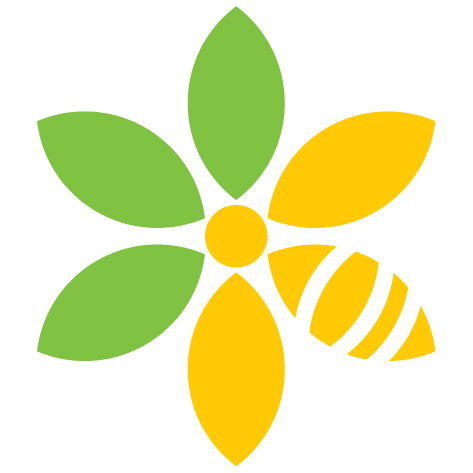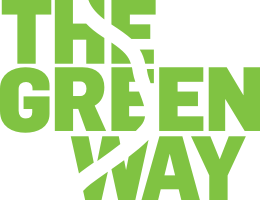Part I: Our Pollinator Ribbon on The Greenway
Written by Tori Hiney, Plant Health Care Horticulturist
Settle in, this blog post is all about the birds and the bees… the real ones!

Watch for this Pollinator Ribbon Icon throughout The Greenway!
Perhaps you’ve heard a bumble about the importance of pollinators recently? It’s quickly becoming quite the buzz-worthy topic, and you know what, we are game! This is why, new to The Greenway’s Pollinator Ribbon, we are introducing 11 “hotels” and shelters for our Bostonian pollineighbors! Now, not only are these hotels and shelters adorable (you’ll have to see for yourselves!), but they also serve as functional habitat additions for our nectar lovin’ friends, especially in an urban environment. Of course for these hotels and shelters to have visitors you can’t just plop one down anywhere. Visitors want more. They want to stay for awhile. For that, they require the right environment; a little tough in downtown Boston, but as they say, if you build it they will come. Well, guess what? We built it, and wouldn’t you know it, they came! A mile and a half of organically maintained, largely native habitat brought them in by the thousands. So before we jump into what these lovely little pollinator homes are all about, let’s talk about who our pollinators are, how they found us, and how we keep them coming!
Who are our pollinators and beneficials?
We have all sorts of pollinators, beneficial insects and fauna on The Greenway. From bees and hoverflies, to butterflies and moths, to ladybugs and lacewings, to birds and even bats! All are extremely important to a healthy ecosystem, and at the same time require ecosystem health to thrive! When we think pollinators, bees often come to mind first, specifically the honey bee. This oh-so-cute bee is very important to the Greenway, and it may well be our most populous daytime pollinator, but certainly not our only one. We also see plenty of mining bees, digger bees, mason bees, and bumblebees floating around our gardens, each playing their own important role to help us sustain our downtown park.
On the maintenance end of the insect spectrum come the beneficial predators such as ladybugs and lacewings. These little beauts are both feisty and powerful! I would hate to be an aphid for a lot of reasons, but mostly because ladybug larvae are so voracious! First, they look like tiny dinosaurs. Second, and probably the important point is that one of these little larvae can mow down 400+ aphids before they reach adulthood, and when that happens…all you soft bodied insects better watch out! An adult ladybug can eat in the ballpark of 5,000 additional aphids in their lifetime! If that wasn’t enough, there is another predator, the lacewing, who can grab all those pests that Miss lady might have missed. The larvae are similar in appearance to that of ladybugs and are just as ferocious and unforgiving. They can consume over 200 soft bodied pests per week!
Now, I love the birds, and the bees, and all of our beneficial bugs, but I will say the most magnificent sight to see in downtown Boston is a Monarch Butterfly! Watching these majestic creatures using The Greenway as a critical and safe reproduction site is amazing to witness. Late summer into fall is when to watch for the Monarchs. The dance typically begins in late August with the third generation Monarchs laying their eggs on the underside of Milkweed leaves to be born into the all mighty fourth generation! To be brief, the fourth generation Monarchs make the journey all the way back to Mexico and will live a whopping 6 months through the winter, whereas its predecessors split their journey North between three generations over the warmer months.
What draws pollinators to the Greenway?
Well, as popular as they are, it’s not our public art, our Greenway Carousel, our water features, or even our Beer Garden that attract polinators! It’s the plants, the soil, the four seasons of life and the ecology our gardens provide. Every pollinator is a bit different, just as every plant species is. This is not a coincidence. Having a diverse selection of flora directly correlates to attracting a diverse population of fauna. Plants and animals have both developed their own techniques for pollination. This is what allows the pollinators to eat and the flowers to be pollinated. This is why there are so many different shapes and sizes of flowers. This is why bumblebees “bumble” or do the shimmy, shimmy shake. It’s how they get fed and how they can get an edge over the competition. Some flowers, like those of potatoes and tomatoes, responded over time and evolved to only allow the precise movements of a bumblebee to release pollen.
But seriously, how did we get the pollinators to come here? You’ve gotta think that a little tiny mason bee is not going to fly 4 miles from the edge of Allston in search of food and shelter. It just wouldn’t make it. Even a honey bee that theoretically could make that flight would likely run into some trouble navigating the city terrain. Well, lucky for all of us Boston has an amazing, growing network of public parks, community gardens, rooftop gardens, rooftop bee sanctuaries, river restoration projects, residential gardens, container displays, urban agriculture on rooftops and walls…on and on. All of these efforts combined help to “defragment” the city habitat and are why we continue to see more pollinators and diverse wildlife! The Greenway’s Pollinator Ribbon adds to this important network of spaces. Stop by soon to check out our new insect habitats and see the return of spring!
For more information, check out Part II: Our Pollinator Ribbon on The Greenway!
